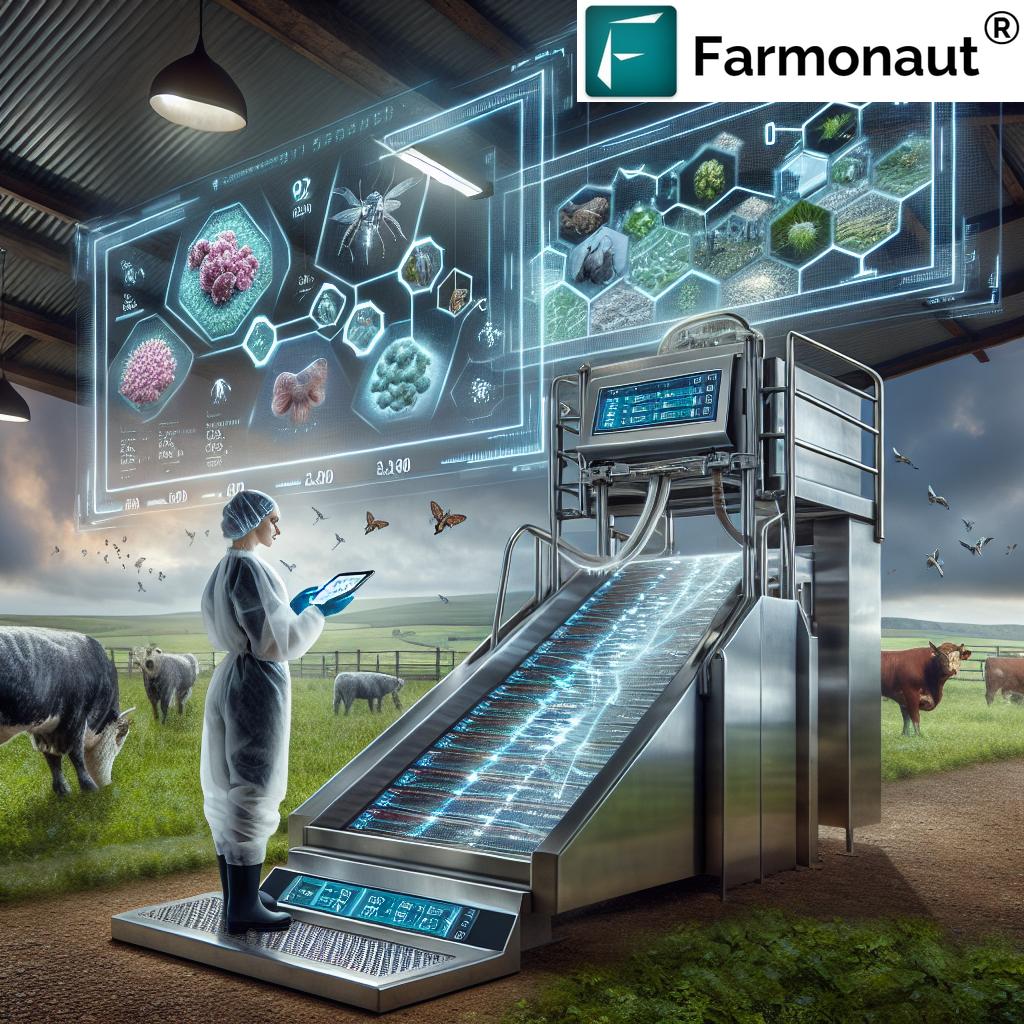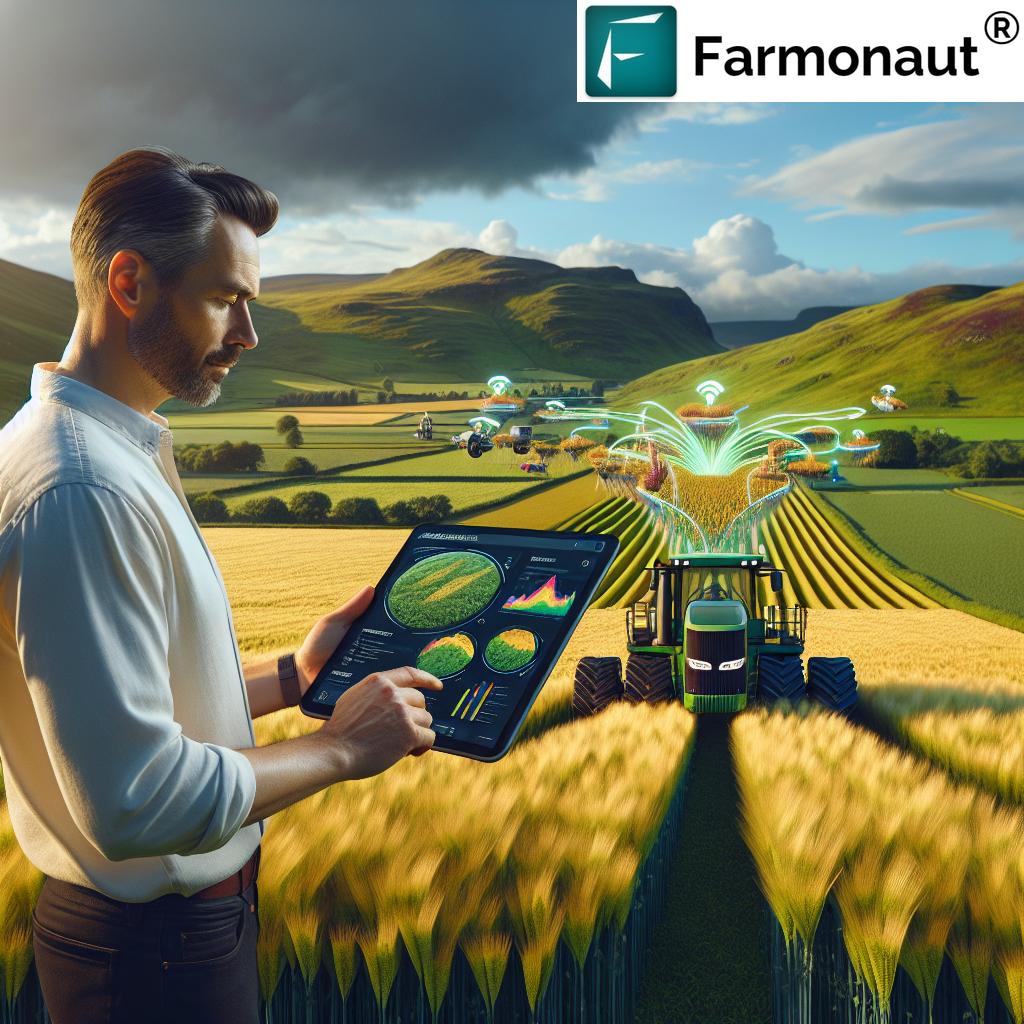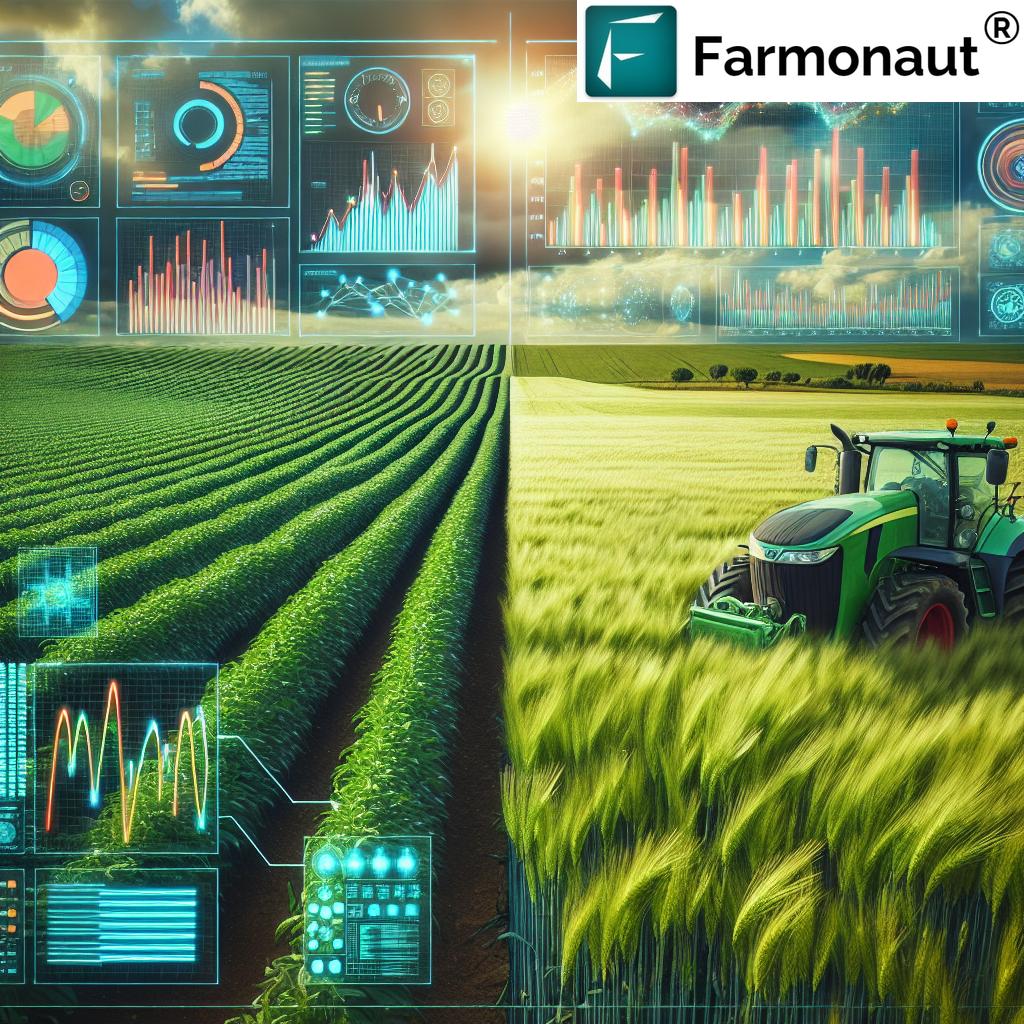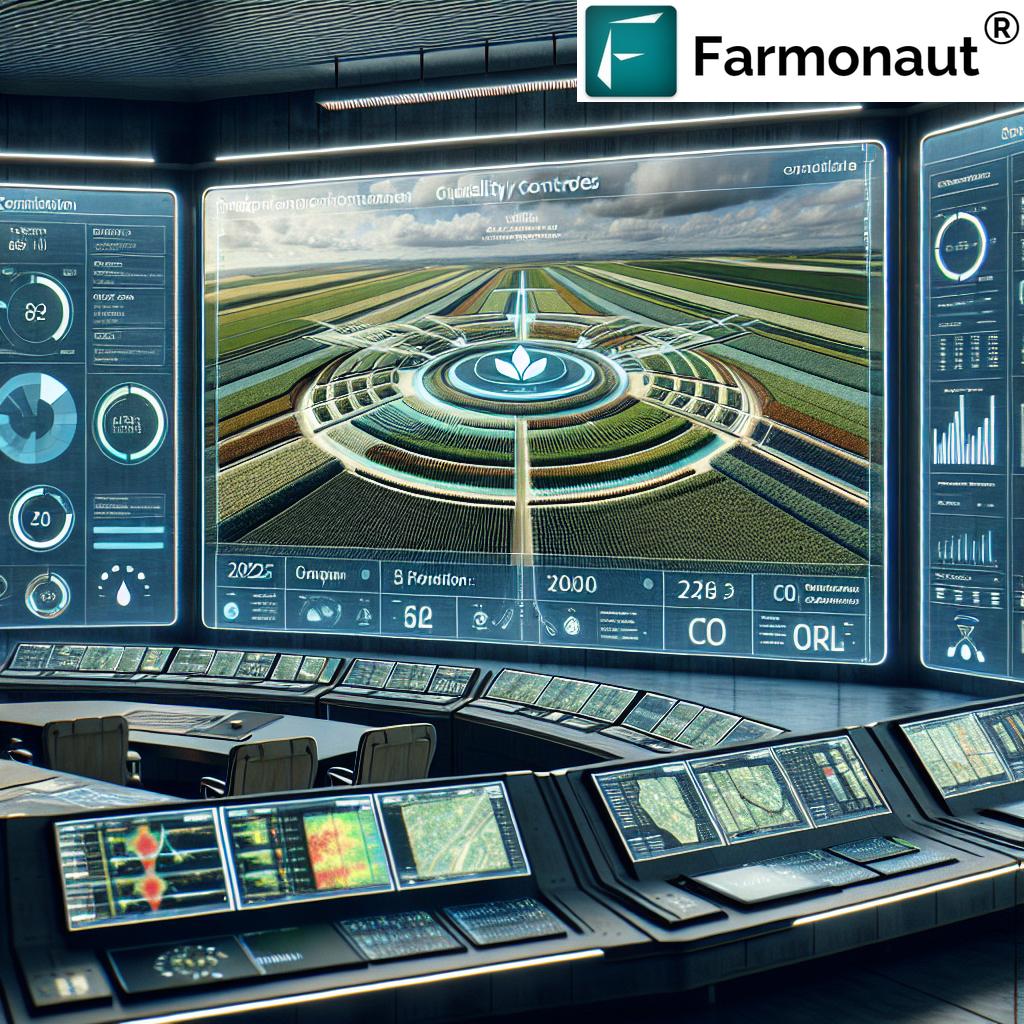Revolutionizing UK Agriculture: How Farmonaut’s GIS and Remote Sensing Solutions Boost Farm Efficiency
“UK farmers using precision agriculture solutions have reported up to 20% increase in crop yields across various regions.”
In the ever-evolving landscape of UK agriculture, we are witnessing a remarkable transformation driven by cutting-edge technologies and innovative farming practices. From the rolling hills of Yorkshire to the fertile plains of Lincolnshire, farmers across England, Scotland, and Wales are embracing modern farming technology to enhance their agricultural efficiency and productivity. At the forefront of this revolution are advanced hydraulic systems in agriculture, precision agriculture solutions, and sophisticated GIS and remote sensing technologies.
In this comprehensive guide, we’ll explore how these groundbreaking innovations are reshaping the face of UK farming, with a special focus on how Farmonaut’s state-of-the-art GIS and remote sensing solutions are complementing and enhancing traditional agricultural practices. Whether you’re managing arable land in Norfolk, overseeing dairy farms in Gloucestershire, or tending to poultry in Carmarthenshire, this article will provide you with essential insights into leveraging these technologies for sustainable growth and improved profitability.
The Rise of Hydraulic Systems in UK Agriculture
Hydraulic systems have become the backbone of modern farming equipment, revolutionizing the way we approach agricultural tasks. These powerful fluid-based mechanisms are integral to the functioning of various farm machinery, from tractors and harvesters to irrigation systems and material handling equipment.
Key Applications of Farming Equipment Hydraulics:
- Tractors and Heavy Machinery: Hydraulic systems power essential functions like steering, braking, and implement control, allowing for precise and efficient operation in diverse field conditions.
- Irrigation Systems: Advanced hydraulic pumps and valves enable farmers to distribute water efficiently across vast agricultural lands, optimizing water usage and crop yields.
- Material Handling: Hydraulic lifts and loaders facilitate the movement of heavy loads, streamlining tasks such as hay baling, grain storage, and livestock feed management.
- Precision Planting and Harvesting: Hydraulically controlled planting and harvesting equipment ensure accurate seed placement and crop collection, minimizing waste and maximizing yield.
The integration of hydraulic systems in agriculture has significantly enhanced the capability and efficiency of farming operations across the UK. From the Scottish Borders to the fields of Surrey, farmers are experiencing unprecedented levels of control and precision in their daily tasks.
[Image 1]
The Impact of Modern Farming Technology on UK Agriculture
As we delve deeper into the 21st century, the adoption of modern farming technology is reshaping the agricultural landscape of the United Kingdom. These innovations are not just improving efficiency; they’re transforming the very nature of farming practices across England, Scotland, and Wales.
Key Technological Advancements:
- Precision Agriculture Solutions: Utilizing GPS technology, sensors, and data analytics to optimize crop management and resource allocation.
- Internet of Things (IoT) Devices: Connected sensors and devices that provide real-time data on soil conditions, weather patterns, and crop health.
- Autonomous Machinery: Self-driving tractors and drones that can perform tasks with minimal human intervention, increasing efficiency and reducing labor costs.
- AI and Machine Learning: Advanced algorithms that analyze vast amounts of agricultural data to provide insights and predictive analytics for better decision-making.
These technologies are particularly transformative in regions like Cheshire, Hertfordshire, and Berkshire, where diverse farming operations benefit from data-driven approaches to agriculture.
The Role of GIS and Remote Sensing in Modern UK Farming
Geographic Information Systems (GIS) and remote sensing technologies have emerged as game-changers in the UK agricultural sector. These powerful tools provide farmers with unprecedented insights into their land and crops, enabling more informed decision-making and resource management.
Benefits of GIS and Remote Sensing in Agriculture:
- Precise Soil Analysis: Detailed mapping of soil types, nutrient levels, and moisture content across vast areas.
- Crop Health Monitoring: Early detection of pest infestations, diseases, and nutrient deficiencies through spectral imaging.
- Yield Prediction: Accurate forecasting of crop yields based on historical data and current conditions.
- Resource Optimization: Efficient allocation of water, fertilizers, and pesticides based on specific field requirements.
Farmonaut’s cutting-edge GIS and remote sensing technologies are at the forefront of this revolution, offering UK farmers powerful tools for comprehensive farm management. Our satellite-based solutions provide real-time insights into crop health, soil conditions, and environmental factors, enabling farmers to make data-driven decisions that optimize their operations.
“Farmonaut’s GIS and remote sensing technologies can analyze soil conditions across 1000+ acres in a single day.”
[Image 2]
Farmonaut: Empowering UK Farmers with Advanced Agricultural Technology
At Farmonaut, we are committed to making precision agriculture accessible and affordable for farmers across the United Kingdom. Our platform integrates satellite imagery, artificial intelligence, and machine learning to provide comprehensive farm management solutions.
Key Features of Farmonaut’s Technology:
- Satellite-Based Crop Health Monitoring: Real-time insights into vegetation health, soil moisture levels, and critical agricultural metrics.
- Jeevn AI Advisory System: Personalized farm advisory tool delivering real-time insights and expert crop management strategies.
- Blockchain-Based Product Traceability: Ensuring transparency and security in agricultural supply chains.
- Fleet and Resource Management: Optimizing the use of agricultural machinery and resources for improved efficiency.
- Carbon Footprinting: Tracking and managing environmental impact for sustainable farming practices.
Our solutions are designed to cater to the diverse needs of UK agriculture, from the arable lands of Suffolk to the dairy farms of Fife. By leveraging Farmonaut’s technology, farmers can significantly enhance their productivity, reduce costs, and contribute to more sustainable agricultural practices.
Explore Farmonaut’s Solutions:
Integrating Hydraulic Systems with Precision Agriculture
The synergy between hydraulic systems in agriculture and precision farming technologies is revolutionizing UK farm operations. This integration is particularly evident in regions like Hampshire, where diverse agricultural practices benefit from this technological convergence.
Key Integration Points:
- Smart Irrigation Systems: Hydraulic pumps controlled by GIS data ensure precise water distribution based on real-time soil moisture analysis.
- Variable Rate Application: Hydraulically-powered sprayers and spreaders adjust their output based on GIS and remote sensing data, optimizing the use of fertilizers and pesticides.
- Automated Harvesting: Combine harvesters with hydraulic systems guided by GPS and crop health data for efficient and targeted harvesting.
- Precision Planting: Hydraulic seed drills controlled by GIS data ensure optimal seed placement and spacing.
This integration is particularly beneficial for large-scale operations in areas like Lincolnshire and Norfolk, where efficient management of vast agricultural lands is crucial.
Farm Machinery Maintenance: Ensuring Longevity and Efficiency
Proper maintenance of farm machinery, especially those with complex hydraulic systems, is crucial for ensuring longevity and optimal performance. This is particularly important in regions like Staffordshire and County Durham, where diverse farming operations rely heavily on machinery.
Essential Maintenance Practices:
- Regular Fluid Checks: Monitoring and maintaining proper hydraulic fluid levels and quality.
- Seal and Hose Inspection: Regularly checking for leaks or wear in hydraulic seals and hoses.
- Filter Replacement: Ensuring hydraulic filters are clean and replaced as per manufacturer recommendations.
- System Pressure Checks: Monitoring hydraulic system pressure to prevent overloading and component damage.
- Precision Calibration: Regular calibration of hydraulic systems integrated with precision farming technologies.
Implementing these maintenance practices not only extends the life of farming equipment but also ensures that precision agriculture solutions function at their peak efficiency.
Agricultural Hydraulic Services: Supporting UK Farmers
The growth of hydraulic systems in agriculture has led to the emergence of specialized agricultural hydraulic services across the UK. These services play a crucial role in maintaining and optimizing farm equipment, particularly in areas like Cambridgeshire and Cheshire, where intensive farming practices are common.
Key Services Offered:
- Hydraulic System Repairs: Specialized repairs for tractors, harvesters, and other hydraulic-powered farm equipment.
- Custom Hydraulic Solutions: Designing and implementing bespoke hydraulic systems for unique farming needs.
- Preventive Maintenance Programs: Regular check-ups and maintenance to prevent costly breakdowns during critical farming periods.
- Hydraulic Component Supply: Providing high-quality hydraulic parts and components for various agricultural machinery.
- Training and Consultation: Educating farmers on proper use and maintenance of hydraulic farming equipment.
These services ensure that UK farmers can maintain their equipment in top condition, maximizing efficiency and minimizing downtime.
Precision Agriculture Solutions: A Game-Changer for UK Farms
Precision agriculture solutions are transforming farming practices across the UK, from the Scottish Borders to the fields of Surrey. These technologies enable farmers to make data-driven decisions, optimizing resource use and improving crop yields.
Key Components of Precision Agriculture:
- GPS Guidance Systems: Enabling accurate field mapping and precise machinery movement.
- Yield Monitoring: Real-time data collection during harvesting for detailed yield analysis.
- Variable Rate Technology (VRT): Adjusting the application of inputs like seeds, fertilizers, and pesticides based on field variability.
- Soil Sampling and Mapping: Detailed analysis of soil composition for optimized crop management.
- Weather Monitoring: Integrating local weather data for improved decision-making in farm operations.
Farmonaut’s GIS and remote sensing technologies complement these precision agriculture solutions, providing farmers with comprehensive data for informed decision-making. Our satellite-based crop health monitoring and AI-driven advisory systems offer invaluable insights for optimizing farm operations.
Explore Farmonaut’s API for Developers: Farmonaut API
Access Our API Documentation: API Developer Docs
The Impact of Modern Farming Technologies on UK Agricultural Efficiency
The adoption of modern farming technologies, including advanced hydraulic systems and precision agriculture solutions, has significantly boosted agricultural efficiency across the UK. From Yorkshire to Gloucestershire, farmers are experiencing tangible benefits in various aspects of their operations.
Key Efficiency Improvements:
- Resource Optimization: Precision application of water, fertilizers, and pesticides, reducing waste and environmental impact.
- Labor Efficiency: Automated systems and machinery reducing the need for manual labor and allowing for more strategic workforce allocation.
- Yield Increase: Data-driven decision-making leading to optimized crop management and increased yields.
- Cost Reduction: More efficient use of inputs and reduced equipment wear resulting in lower operational costs.
- Time Savings: Automated processes and precise operations reducing the time required for various farming tasks.
These improvements are particularly evident in regions like Berkshire and Suffolk, where diverse agricultural practices benefit from technological advancements.
Hydraulic Components for Tractors: The Heart of Modern Farm Machinery
Tractors are the workhorses of modern agriculture, and their hydraulic components play a crucial role in their versatility and efficiency. Understanding these components is essential for farmers across the UK, from the dairy farms of Carmarthenshire to the arable lands of Lincolnshire.
Key Hydraulic Components in Tractors:
- Hydraulic Pumps: Generate the pressure needed to power various tractor functions.
- Control Valves: Direct hydraulic fluid to different parts of the tractor as needed.
- Cylinders: Convert hydraulic pressure into mechanical force for lifting and moving implements.
- Hydraulic Motors: Provide rotational power for various attachments and functions.
- Hydraulic Reservoirs: Store and cool hydraulic fluid, ensuring system efficiency.
These components work in harmony to power essential tractor functions, from steering and braking to powering attachments and implements. Regular maintenance and proper use of these hydraulic components are crucial for ensuring the longevity and efficiency of tractors in UK farming operations.
UK Agricultural Directory: A Resource for Modern Farmers
As the UK farming landscape evolves with the integration of advanced technologies, access to comprehensive resources becomes crucial. While Farmonaut is not a directory service, we recognize the importance of farmers having access to a wide range of agricultural resources and services.
Key Resources for UK Farmers:
- Equipment Suppliers: Sourcing modern farming machinery and hydraulic components.
- Agricultural Consultants: Experts in precision farming and technological integration.
- Training Programs: Workshops and courses on using advanced farming technologies.
- Research Institutions: Organizations conducting cutting-edge agricultural research.
- Government Agencies: Bodies providing support, regulations, and funding opportunities for farmers.
While Farmonaut focuses on providing cutting-edge GIS and remote sensing solutions, we encourage farmers to utilize comprehensive directories and resources to fully leverage the benefits of modern farming technologies.
The Future of UK Agriculture: Integrating Technology and Tradition
As we look to the future of UK agriculture, it’s clear that the integration of advanced technologies with traditional farming practices will play a pivotal role. From the Scottish Highlands to the fields of Hampshire, this blend of innovation and experience is shaping a more efficient, sustainable, and productive agricultural sector.
Key Trends Shaping the Future:
- Artificial Intelligence in Farming: AI-driven decision support systems for crop management and resource allocation.
- Autonomous Farm Machinery: Self-driving tractors and drones for various farming operations.
- Vertical Farming: High-tech indoor farming solutions for urban and peri-urban areas.
- Blockchain in Agriculture: Enhancing traceability and transparency in the food supply chain.
- Sustainable Farming Practices: Integrating technology to reduce environmental impact and promote conservation.
Farmonaut is at the forefront of this agricultural revolution, continuously developing and refining our GIS and remote sensing technologies to meet the evolving needs of UK farmers. Our commitment to making precision agriculture accessible and affordable aligns perfectly with the future direction of UK farming.
Comparative Analysis: Traditional vs. Farmonaut-Enhanced Farming in the UK
| Agricultural Aspect | Traditional Farming | Farmonaut-Enhanced Farming |
|---|---|---|
| Soil Analysis Accuracy | Limited, based on periodic sampling | Comprehensive, real-time satellite data analysis |
| Crop Monitoring Efficiency | Manual, time-consuming | Automated, continuous satellite monitoring |
| Disease Detection Speed | Slow, often reactive | Rapid, proactive detection through spectral analysis |
| Water Usage Optimization | Generalized irrigation schedules | Precision irrigation based on real-time soil moisture data |
| Overall Farm Productivity | Variable, dependent on experience | Consistently high, data-driven decision making |
Farmonaut: Your Partner in Modern UK Agriculture
As we’ve explored throughout this article, the integration of advanced technologies like GIS, remote sensing, and hydraulic systems is revolutionizing UK agriculture. Farmonaut stands at the forefront of this revolution, offering cutting-edge solutions that empower farmers across England, Scotland, and Wales to optimize their operations and boost productivity.
Our comprehensive suite of tools, from satellite-based crop health monitoring to AI-driven advisory systems, provides UK farmers with the insights they need to make informed decisions. Whether you’re managing vast arable lands in Yorkshire or overseeing dairy farms in Gloucestershire, Farmonaut’s technologies can help you achieve new levels of efficiency and sustainability in your farming practices.
We invite you to explore how Farmonaut can transform your agricultural operations:
Frequently Asked Questions
Q: How does Farmonaut’s technology integrate with existing farming equipment?
A: Farmonaut’s GIS and remote sensing solutions are designed to complement existing farming equipment. Our data can be used to optimize the operation of tractors, irrigation systems, and other machinery equipped with precision agriculture capabilities.
Q: Is Farmonaut’s technology suitable for small-scale farmers in the UK?
A: Absolutely. Farmonaut offers scalable solutions that cater to farms of all sizes. Our goal is to make precision agriculture accessible and affordable for all UK farmers, from small family-run operations to large commercial farms.
Q: How frequently is satellite data updated in Farmonaut’s system?
A: The frequency of satellite data updates depends on the specific service package. However, we typically provide updates every few days, ensuring that farmers have access to recent and relevant data for decision-making.
Q: Can Farmonaut’s technology help with compliance to UK agricultural regulations?
A: While Farmonaut is not a regulatory body, our detailed data on farm operations, including resource usage and environmental impact, can assist farmers in demonstrating compliance with various UK agricultural regulations.
Q: How does Farmonaut ensure the security and privacy of farm data?
A: Data security is a top priority at Farmonaut. We employ robust encryption methods and adhere to strict data protection protocols to ensure the confidentiality and integrity of all farm data processed through our systems.
Conclusion: Embracing the Future of UK Agriculture
As we’ve explored in this comprehensive guide, the integration of advanced technologies like Farmonaut’s GIS and remote sensing solutions, alongside modern hydraulic systems and precision agriculture tools, is revolutionizing UK agriculture. From the arable lands of Norfolk to the dairy farms of Fife, these innovations are empowering farmers to achieve unprecedented levels of efficiency, productivity, and sustainability.
By embracing these technologies, UK farmers are not just improving their current operations; they’re paving the way for a more resilient and productive agricultural sector. As we look to the future, it’s clear that the continued integration of data-driven solutions and advanced machinery will play a crucial role in meeting the challenges of food security, environmental conservation, and economic sustainability in UK farming.
We at Farmonaut are proud to be at the forefront of this agricultural revolution, providing UK farmers with the tools they need to thrive in an ever-evolving industry. As you consider the next steps for your farming operation, we invite you to explore how Farmonaut’s solutions can help you unlock the full potential of your land and resources.
Together, let’s cultivate a brighter, more efficient future for UK agriculture.
















